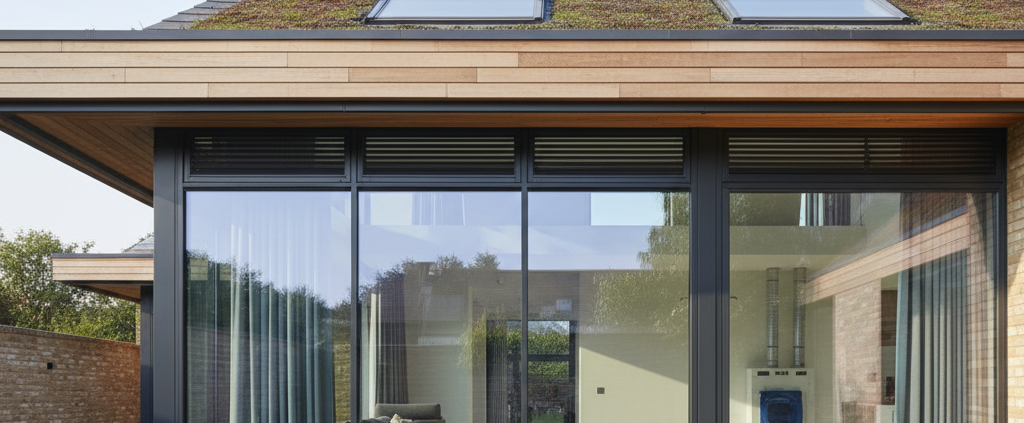A Look Ahead: What the 2026 Regulations Mean for Glass Doors and Skylights
The UK is moving fast towards its Net Zero carbon targets, and the construction industry is at the forefront of this change. While the Future Homes Standard (FHS) is often cited with a 2025/2026 implementation date, the key changes that will affect glass doors and skylights have been steadily tightening since the 2022 Part L update. The full rollout of the FHS will dramatically enforce these standards, making thermal performance non-negotiable for all new builds and setting a high bar for renovations.
Here is a breakdown of the critical changes focusing on thermal performance, solar control, and ventilation for glazed elements.
1. Thermal Performance: The U-Value Tightens
The most significant change is the enforcement of lower U-values, which measure the rate of heat loss through a component (Watts per square metre per Kelvin, or ). The lower the U-value, the better the insulation.
New-Build Properties (Under the Future Homes Standard):
The drive is towards a zero-carbon-ready home. The final FHS U-value figures for new dwellings are highly stringent, essentially making high-performance double glazing a minimum and triple glazing a strong contender for compliance and future-proofing.
Key Insight: To achieve the overall performance target of the Future Homes Standard, many builders will find it necessary to specify windows and doors that beat the minimum U-value, potentially pushing many specifications towards triple-glazed units to offset other design features.
Existing Properties (Replacements and Renovations):
While new builds face the strictest standards, replacements in existing homes will also need to meet enhanced Part L requirements, which are already tougher than pre-2022.
- Replacement Windows/Glazed Doors: A maximum U-value of .
- Replacement Rooflights/Skylights: A maximum U-value of .
2. Overheating Control (Approved Document O)
As homes become highly insulated and airtight, the risk of overheating from solar gain becomes a major concern—especially with large expanses of glass.
The new regulations, enforced via Approved Document O, mandate measures to control solar gain. This directly affects the specification and design of large glass doors (like bi-folds and sliding doors) and skylights, particularly on south and west-facing elevations.
- Solar Control Glazing (Low g-value): Glazing units must be specified with a lower ‘g-value’ (Solar Heat Gain Coefficient), which limits the amount of solar heat entering the building.
- Shading Devices: The regulations promote the use of external shading strategies to prevent heat from reaching the glass in the first place. This includes:
- Overhangs and Canopies
- External Blinds or Shutters
- Louvres or Brise Soleil
Action Point: Designers must now consider the orientation and size of glazed areas in conjunction with shading solutions to ensure the dwelling does not overheat. This is a crucial design shift for modern homes that favour large glass facades.
3. Ventilation Requirements (Approved Document F)
The superior airtightness required to meet the lower U-values means relying on natural air leakage for ventilation is no longer an option.
- Mandatory Trickle Vents: When replacing or installing new windows and glass doors in habitable rooms, trickle vents are now generally required by Part F to ensure continuous background ventilation. This is critical for maintaining indoor air quality and preventing condensation and mould.
- MVHR Systems: For high-performance new builds, Mechanical Ventilation with Heat Recovery (MVHR)systems are often specified. These systems use the high level of airtightness to their advantage, exchanging stale indoor air with fresh outdoor air while recovering heat.
Summary for Professionals and Homeowners
The 2026 landscape is defined by the Future Homes Standard and its underlying principle of “fabric first.” For glass doors and skylights, this means:
- Triple Glazing is the New Gold Standard: While high-performance double glazing may still meet the minimum for some areas, specifying a triple-glazed system offers the best path to effortless compliance and a genuinely future-proofed, comfortable home.
- Design for Comfort: Compliance now involves balancing heat loss (U-value) with heat gain (g-value) and ventilation (Part F/MVHR). Large glazed areas require a comprehensive solar control strategy.
- Whole-System Approach: The focus is on the thermal performance of the entire assembly—the glass, the frame (including its thermal break), the seals, and the installation details (thermal bridging). Photographic evidence of the installation at critical junctions will be a part of the compliance process.
The era of simply fitting a low-cost, standard-specification glass product is ending. The new regulations demand integrated, high-performance glazing solutions as a critical component of a sustainable, energy-efficient UK home.





Leave a Reply
Want to join the discussion?Feel free to contribute!